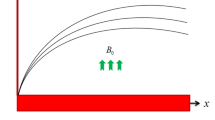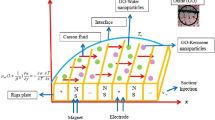Abstract
Heat transportation advancement in liquid is a crucial work which can be easily obtained via utilization of hybrid nanoparticles. Therefore, main concern of the current article is to address the entropy aspects in Dracy-Forchheimer flow of hybrid nanomaterials (kerosene oil, SWCNT and MWCNT). The novel features of Xue's which is modified and implemented for flow physical empirical relations (thermal conductivity, density and specific heat). Furthermore, entropy concept is utilized to estimate the frame of analysis disorderness. The transformed expressions have been computed through numerical scheme after conversion to ODEs by dimensionless variables. Graphical illustrations and tables are made to investigate the effects of noteworthy embedding variables on various distributions. Moreover, detailed analysis for temperature and velocity gradients against pertinent parameters at the surface is provided. Obtained findings reflect that temperature upgraded for both nanoliquid and hybrid nanoliquid by rising Eckert number and heat source parameter, whereas an opposite features is pointed out for gradient of temperature. It is also perceived that skin friction escalates for inertia coefficient, rotation parameter and porosity parameter. There is remarkable increase for SWCNT-MWCNT/kerosene oil hybrid nanofluid when compared with SWCNT/kerosene oil nanoliquid. Overall, hybrid nano phase has an incredible effect in comparison to nanomaterials.

















Similar content being viewed by others
References
Choi SUS, Eastman JA. Enhancing thermal conductivity of fluids with nanoparticles. ASME Publication- Fed. 1995;231:99–106.
Eastman JA, Choi SU, Li S, Yu W, Thompson LJ. Anomalously increased effective thermal conductivities of ethylene glycol-based nanofluids containing copper nanoparticles. Appl Phys Lett. 2001;78:718–20.
Das SK, Choi SU, Patel HE. Heat transfer in nanofluids a review. Heat Transf Eng. 2006;27:3–19.
Xue Q, Xu WM. A model of thermal conductivity of nanofluids with interfacial shells. Mater Chem Phys. 2005;90:298–301.
Wakif A, Boulahia Z, Sehaqui R. A semi-analytical analysis of electro-thermo-hydrodynamic stability in dielectric nanofluids using Buongiorno’s mathematical model together with more realistic boundary conditions. Results Phys. 2018;9:1438–54.
Wakif A, Boulahia Z, Mishra SR, Rashidi MM, Sehaqui R. Influence of a uniform transverse magnetic field on the thermo-hydrodynamic stability in water-based nanofluids with metallic nanoparticles using the generalized Buongiorno’s mathematical model. Eur Phys J Plus. 2018;133:181.
Wakif A, Boulahia Z, Sehaqui R. Numerical study of the onset of convection in a Newtonian nanofluid layer with spatially uniform and non uniform internal heating. J Nanofluids. 2017;6:136–48.
Dogonchi AS, Ismael MA, Chamkha AJ, Ganji DD. Numerical analysis of natural convection of Cu–water nanofluid filling triangular cavity with semicircular bottom wall. J Therm Anal Calorim. 2019;135:3485–97.
Ullah I, Hayat T, Alsaedi A, Asghar S. Modeling for radiated Marangoni convection flow of magneto-nanoliquid subject to Activation energy and chemical reaction. Sci Iran. 2020;27:3390–8.
Mahanthesh B, Gireesha BJ, Animasaun IL, Muhammad T, Shashikumar NS. MHD flow of SWCNT and MWCNT nanoliquids past a rotating stretchable disk with thermal and exponential space dependent heat source. Phys Scr. 2019;94:085214.
Hayat T, Ullah I, Muhammad T, Alsaedi A. Hydromagnetic squeezed flow of second-grade nanomaterials between two parallel disks. J Therm Anal Calorim. 2020;139:2067–77.
Mahanthesh B, Gireesha BJ, Prasannakumara BC, Kumar PS. Magneto-Thermo-Marangoni convective flow of Cu-H2O nanoliquid past an infinite disk with particle shape and exponential space based heat source effects. Results phys. 2017;7:2990–6.
Makinde OD, Mahanthesh B, Gireesha BJ, Shashikumar NS, Monaledi RL, Tshehla MS. MHD nanofluid flow past a rotating disk with thermal radiation in the presence of aluminum and titanium alloy nanoparticles. Defect Diffusion Forum. 2018;384:69–79.
Ullah I, Hayat T, Alsaedi A, Asghar S. Dissipative flow of hybrid nanoliquid (H2O-aluminum alloy nanoparticles) with thermal radiation. Phys Scr. 2019;94:125708.
Seyyedi SM, Dogonchi AS, Ganji DD, Hashemi-Tilehnoee M. Entropy generation in a nanofluid-filled semi-annulus cavity by considering the shape of nanoparticles. J Therm Anal Calorim. 2019;138:1607–21.
Dogonchi AS, Armaghani T, Chamkha AJ, Ganji DD. Natural convection analysis in a cavity with an inclined elliptical heater subject to shape factor of nanoparticles and magnetic field. Arab J Sci Eng. 2019;44:7919–31.
Alsaadi FE, Ullah I, Hayat T, Alsaadi FE. Entropy generation in nonlinear mixed convective flow of nanofluid in porous space influenced by Arrhenius activation energy and thermal radiation. J Therm Anal Calorim. 2019;12:1–11.
Dogonchi AS. Heat transfer by natural convection of Fe3O4-water nanofluid in an annulus between a wavy circular cylinder and a rhombus. Int J Heat Mass Transfer. 2019;130:320–32.
Uddin I, Ullah I, Ali R, Khan I, Nisar KS. Numerical analysis of nonlinear mixed convective MHD chemically reacting flow of Prandtl-Eyring nanofluids in the presence of activation energy and Joule heating. J Therm Anal Calorim. 2020;15:1–11.
Boulahia Z, Wakif A, Chamkha AJ, Amanulla CH, Sehaqui R. Effects of wavy wall amplitudes on mixed convection heat transfer in a ventilated wavy cavity filled by copper-water nanofluid containing a central circular cold body. J Nanofluids. 2019;8:1170–8.
Hayat T, Muhammad K, Ullah I, Alsaedi A, Asghar S. Rotating squeezed flow with carbon nanotubes and melting heat. Phys Scr. 2019;94:035702.
Moghaddaszadeh N, Esfahani JA, Mahian O. Performance enhancement of heat exchangers using eccentric tape inserts and nanofluids. J Therm Anal Calorim. 2019;137:865–77.
Rashidi S, Eskandarian M, Mahian O, Poncet SJ. Combination of nanofluid and inserts for heat transfer enhancement. JTherm Anal Calorim. 2019;135:437–60.
Hamzah MH, Sidik NA, Ken TL, Mamat R, Najafi G. Factors affecting the performance of hybrid nanofluids: a comprehensive review. Int J Heat Mass Transfer. 2017;115:630–46.
Kumar DD, Arasu AV. A comprehensive review of preparation, characterization, properties and stability of hybrid nanofluids. Renew Sust Energ Rev. 2018;81:1669–89.
Suresh S, Venkitaraj KP, Hameed MS, Sarangan J. Turbulent heat transfer and pressure drop characteristics of dilute water based Al2O3–Cu hybrid nanofluids. J Nanosci Nanotechnol. 2014;14:2563–72.
Harandi SS, Karimipour A, Afrand M, Akbari M, D’Orazio A. An experimental study on thermal conductivity of F-MWCNTs–Fe3O4/EG hybrid nanofluid: effects of temperature and concentration. Int Commun Heat Mass Transfer. 2016;76:171–7.
Ghadikolaei SS, Hosseinzadeh K, Ganji DD. Investigation on ethylene glycol-water mixture fluid suspend by hybrid nanoparticles (TiO2-CuO) over rotating cone with considering nanoparticles shape factor. J Mol Liq. 2018;272:226–36.
Rostami MN, Dinarvand S, Pop I. Dual solutions for mixed convective stagnation-point flow of an aqueous silica–alumina hybrid nanofluid. Chin J Phys. 2018;56:2465–78.
Bejan A. A study of entropy generation in fundamental convective heat transfer. J Heat Transfer. 1979;101:718–25.
Bejan A. Entropy generation through heatand fluid flow. New York: Wiley; 1982.
Mustafa M, Pop I, Naganthran K, Nazar R. Entropy generation analysis for radiative heat transfer to Bödewadt slip flow subject to strong wall suction. Eur J Mech B-Fluids. 2018;72:179–88.
Shehzad SA, Madhu M, Shashikumar NS, Gireesha BJ, Mahanthesh B. Thermal and entropy generation of non-Newtonian magneto-Carreau fluid flow in microchannel. J Therm Anal Calorim. 2020:1–11.
Ullah I, Hayat T, Alsaedi A, Fardoun HM. Numerical treatment of melting heat transfer and entropy generation in stagnation point flow of hybrid nanomaterials (SWCNT-MWCNT/engine oil). Mod Phys Lett. B. 2021:2150102.
Xue QZ. Model for thermal conductivity of carbon nanotube-based composites. Phys B. 2005;368:302–7.
Hayat T, Ullah I, Farooq M, Alsaedi A. Analysis of non-linear radiative stagnation point flow of Carreau fluid with homogeneous-heterogeneous reactions. Microsyst Technol. 2019;25:1243–50.
Hayat T, Ullah I, Alsaedi A, Ahmad B. Numerical simulation for homogeneous–heterogeneous reactions in flow of Sisko fluid. J Braz Soc Mech Sci Eng. 2018;40:1–9.
Ullah I, Ali R, Khan I, Nisar KS. Insight into kerosene conveying SWCNT and MWCNT nanoparticles through a porous medium: Significance of Coriolis force and entropy generation. Phys Scr. 2021;96:055705.
Seth GS, Kumar R, Bhattacharyya A. Entropy generation of dissipative flow of carbon nanotubes in rotating frame with Darcy-Forchheimer porous medium: a numerical study. J Mol Liq. 2018;268:637–46.
Author information
Authors and Affiliations
Corresponding author
Additional information
Publisher's Note
Springer Nature remains neutral with regard to jurisdictional claims in published maps and institutional affiliations.
Rights and permissions
About this article
Cite this article
Ullah, I., Hayat, T. & Alsaedi, A. Optimization of entropy production in flow of hybrid nanomaterials through Darcy–Forchheimer porous space. J Therm Anal Calorim 147, 5855–5864 (2022). https://doi.org/10.1007/s10973-021-10830-2
Received:
Accepted:
Published:
Issue Date:
DOI: https://doi.org/10.1007/s10973-021-10830-2




